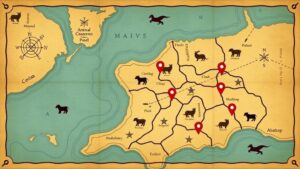Exploring Remote Forest Edges for Evidence of Seasonal Camps
Exploring Remote Forest Edges for Evidence of Seasonal Camps
The study of remote forest edges has gained considerable traction in the field of anthropology and archaeology, particularly in the context of understanding the seasonal camps used by hunter-gatherer societies. By exploring these lesser-known areas, researchers can uncover invaluable insights into the social behaviors, subsistence strategies, and environmental adaptations of prehistoric communities. This article delves into the methodologies employed in such explorations, the significance of findings, and the implications for our understanding of human history.
The Importance of Forest Edges
Forest edges, defined as the transitional zones between forested areas and other ecosystems such as grasslands or wetlands, are often rich in resources. e locations typically offer a combination of diverse flora and fauna, sustainable food supplies, and shelter, making them ideal sites for seasonal camps. Studies show that these edges can sustain higher biodiversity, with a 50% increase in species richness compared to interiors of forests.
- Edges provide access to both forest resources and open ground resources.
- The mixing of different plant communities can lead to greater food availability.
Methodologies for Investigation
To effectively investigate remote forest edges for evidence of seasonal camps, archaeologists and anthropologists utilize several methodologies, including:
- Field Surveys: Systematic surface surveys help identify artifacts and remnants of human activity.
- Geospatial Analysis: Geographic Information Systems (GIS) are deployed to map spatial relationships and patterns.
- Excavation: Targeted excavations at promising sites yield artifacts, ecofacts, and evidence of habitation.
For example, researchers in the Pacific Northwest of the United States have conducted extensive surveys along the edges of temperate rainforests. Their findings revealed lithic tools and organic residues indicative of seasonal hunting camps, thus enriching the understanding of the areas prehistoric occupation.
Case Study: The Southern Appalachian Forests
In the Southern Appalachian region, excavation and analysis of forest edge sites have unveiled substantial evidence of seasonal camps used by indigenous peoples. Archaeologists discovered a range of artifacts, including stone tools and pottery fragments, dating back over 3,000 years. One notable site, dating to the Middle Woodland period, contained evidence suggesting that people used these forest edges for berry gathering and hunting.
A team from the University of Tennessee employed a combination of surface surveys and excavation to document the distribution of artifacts. Their findings pointed to a pattern of seasonal mobility, where groups would migrate depending on resource availability, including game migration and seasonal plant growth.
Environmental Considerations
Understanding the environmental factors influencing the choice of camp locations is crucial. Remote forest edges are dynamic environments that change with the seasons. Factors such as soil composition, microclimates, and proximity to water sources play significant roles in determining the suitability of a location for human habitation.
For example, research indicates that hunter-gatherers often sought areas where water bodies met forested areas, enhancing the availability of both aquatic and terrestrial resources. This ecological strategy allowed for a diversified diet and enhanced survival, especially during harsh winter months.
Implications for Modern Management and Conservation
Insights gained from exploring remote forest edges have broader implications for modern forest management and conservation practices. By understanding how ancient populations utilized these landscapes, contemporary conservationists can develop strategies that respect and preserve these ecosystems for future generations.
- Integrating traditional ecological knowledge with modern conservation efforts.
- Useing sustainable land-use practices that consider biodiversity and cultural heritage.
Plus, as climate change continues to reshape forest ecosystems, lessons learned from historical human adaptations to environmental fluctuations can inform current responses to biodiversity loss and habitat fragmentation.
Conclusion
Exploring remote forest edges for evidence of seasonal camps offers a window into the adaptive strategies of prehistoric human societies. By utilizing diverse methodologies and focusing on environmental contexts, researchers can piece together how ancient populations interacted with their landscapes. As we continue to investigate these vital areas, the knowledge gained not only enhances our understanding of human history but also guides contemporary conservation and land-use strategies.
Future research should prioritize interdisciplinary approaches, combining archaeological findings with ecological studies to better understand the intricate relationships between human activities and environmental changes. Such an approach will ensure that we honor both our past and the ecological integrity of the landscapes we inhabit.



